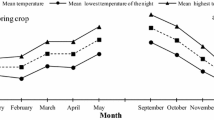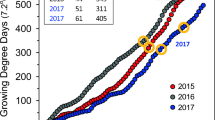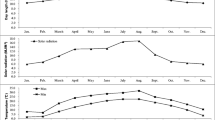Summary
Experiments were conducted with the cultivar Up-to-date to study the relationship between gibberellin level and tuber initiation. Tuberization resulted in case of all treatments which led to a decrease in the endogenous gibberellin level. This observation is also applicable to most of the results published by other research workers. It is postulated that a balance between gibberellins and other endogenous growth substances (especially inhibitors) controls the tuberization process, and that tuber initiation results as soon as the gibberellin content decreases beneath a threshold level.
Zusammenfassung
An der Universität von Pretoria wurden mit der Kartoffelstorte Up-to-Date Versuche durch-geführt, um den Zusammenhang zwischen dem Gibberellinniveau und der Auslösung der Knollenbildung zu untersuchen. In nicht induktiven Photoperioden erfolgte eine Knollenbildung, wenn die junge Blätter und die meristematischen Spitzen entfernt wurden. In diesen Pflanzen konnte die Knollenbildung durch Anwendung von Gibberellinsäure gehemmt werden. Die sich entwickelnden Blätter schienen unter Langtagbedingungen eine Substanz, wahrscheinlich Gibberellin, zu entwickeln, welche die Knollenbildung verzögerte.
Beigabe von CCC zum Wurzelnährboden führte zum fast gleichen Grad der Knollenbildung, wie wenn die Pflanzen durch kurze Tageslängen zur Knollenbildung angeregt wurden. Diese Wirkung des CCC wurde durch Anwendung von Gibberellinsäure zu den jungen Blättern nahezu ganz aufgehoben. Verwendung von Gibberellinsäure zu Pflanzen, die unter Kurztagbedingungen zur Knollenbildung angeregt wurden, hatte auch eine nachteilige Wirkung auf die Knollenbildung. Wenn GA und CCC gleichzeitig angewendet wurden, hing die Reaktion von den jeweiligen Konzentrationen der angewendeten Mittel ab (siehe Tabelle 1 und Abb. 1).
Es wird vorausgesetzt, dass Knollenbildung normalerweise durch hoch wirksame Gibberellin niveaux verhindert wird und dass eine Knollenbildung erfolgt, sobald das Gibberellinniveau auf ein kritisches Mass herabgesetzt wird. Wenn eine spezifisch knollenbildende Substanz mit im spiele ist, dann ist sie auch in nicht induzierten Kartoffelpflanzen vorhanden. Umweltbedingungen können das Gleichgewicht zwischen den Gibberellinen und den endogenen Hemmern (und wahrscheinlich andern Wachstumssubstanzen) beeinflussen, indem sie ihr Niveau oder ihre Aktivität beeinträchtigen. Ein deutlicher Beweis für die wahrscheinliche Rolle des Gibberellins im Knollenbildungsprozess wird in Abb. 2 dargestellt.
Résumé
Des espériences ont été exécutées à l'Université de Pretoria, sur le cultivar Up-to-Date, dans le but d'étudier la relation entre le niveau de gibberelline et l'initiation des tubercules. La tubérisation était réalisée en photopériodes non-inductives alors que les jeunes feuilles et les sommets méristématiques de tiges sont enlevés. On pouvait inhiber la tubérisation dans ces plantes par application d'acide giberrellique. Les feuilles en développement semblaient produire une substance dans des conditions de jours longs, probablement la gibberelline, qui retardait la tubérisation.
L'application de CCC au système radiculaire provoquait un degré presque identique de tubérisation que lorsque l'induction était provoquée par par de courtes photopériodes. Cet effet du CCC est presque complètement annihilé par l'application d'acide gibberellique aux jeunes feuilles. L'application d'acide gibberellique aux plantes à tubérisation induite par de courtes photopériodes a également un effet opposé à la tubérisation. Lorsqu'on applique simultanément GA et CCC, la réaction dépend des con-(voir tableau 1 et fig. 1).
Il est admis que la tubérisation est normalement inhibée par de hauts niveaux de gibberelline active et que la tubérisation se déclenche aussitôt que le niveau gibberellique est abaissé en-dessous d'un seuil critique. Si une substance spécifique formatrice de tubercules est impliquée, elle est également présente dans les plantes de pomme de terre non induites. Les conditions de milieu peuvent influencer l'équilibre entre les gibberellines et les inhibiteurs endogènes (et probablement d'autres substances de croissance) en agissant sur le niveau ou l'activité de quelquesuns d'entr'eux. La fig. 2 apporte quelque preuve du rôle probable de la gibberelline dans le processus de tubérisation.
Similar content being viewed by others
References
Bernard, N., 1902.Rev. gén Bot. 14: 5–269. (Cited by Madec, 1963.)
Bodlaender, K. B. A., 1960. De invloed van de temperatuur op de ontwikkeling van de aardappel.Jaarb. Inst. biol. scheik. Onderz. LandbGew., Wageningen.
El-Antably, H. M. M., P. F. Wareing & Hillman, J., 1967. Some physiological responses to d,l-abscisin (dormin).Planta 73: 74–90.
Evans, L. T., 1971. Flower-induction and the florigen concept.A. Rev. Pl. Physiol. 22: 365–394.
Garcia-Torres, L. & C. Gomez-Campo, 1973. In vitro tuberization of potato sprouts as affected by ethrel and gibberellic acid.Potato Res. 16: 73–79.
Gregory, L. E., 1956. Some factors for tuberization in the potato plant.Am. J. Bot. 43: 281–288.
Gregory, L. E., 1965. Physiology of tuberization in plants. (Tubers and tuberous roots). In: W. Ruhland (Ed.), Encyclopedia of plant physiology, Vol. XV. Differentiation and development. Berlin: Springer-Verlag, Berlin.
Hammes, P. S., 1972. Knolvorming by aartappels.Gewasproduksie 1: 71–75.
Hammes, P. S. & E. A. Beyers, 1973. Localization of the photoperiodic perception in potatoes.Potato Res. 16: 68–72.
Hammes, P. S., P. C. Nel & E. A. Beyers, 1974. Die fotoperiodiese induksie by aartappels.Gewasproduksie 3 (in press).
Holst, Ulla-Britt, 1971. Some properties of inhibitor β fromSolanum tuberosum compared to abscisic acid.Physiologia Pl. 24: 392–396.
Jones, R. L., 1973. Gibberellins: Their physiological role.A. Rev. Pl. Physiol. 24: 571–598.
Jones, R. L. & I. D. J. Phillips, 1966. Organs of gibberellin synthesis in light-grown sunflowers plants.Pl. Physiol. 41: 1381–1386.
Jones, R. L. & I. D. J. Phillips, 1967. Effect of CCC on the gibberellin content of excised sunflower organs.Planta 72: 53–59.
Kefeli, V. I. & C. S. Kadyrov, 1971. Natural growth inhibitors, their chemical and physiological properties.A. Rev. Pl. Physiol. 22: 185–196.
Kumar, D. & P. F. Wareing, 1972. Studies on tuberization inSolanum andigena. 1. Evidence for the existence and movement of a specific tuberization stimulus.New Phytol. 72, 283–287.
Lang, A., 1970. Gibberellins: Structure and metabolism.A. Rev. Pl. Physiol. 21, 537–570.
Madec, P., 1963. Tuber-forming substances in the potato. In: J. D. Ivins & F. L. Milthorpe, (Ed.), The growth of the potato. Butterworths, Londen.
Okazawa, Y., 1960. Studies on the relation between the tuber formation of potato and its natural gibberellin content (Jap.).J. Crop. Sci. Soc. Japan 29: 121–124. (Cited by Slater, 1963; Gregory, 1965.)
Okazawa, Y. & H. W. Chapman, 1962. Regulation of tuber formation in the potato plant.Physiologia Pl., 15: 413–419.
Palmer, C. E. & W. G. Barker, 1973. Influence of ethylene and kinetin on tuberization and enzyme activity inSolanum tuberosum L. stolons culturedin vitro.Ann. Bot. 37: 85–93.
Palmer, C. E. & O. E. Smith, 1969a. Effect of abscisic acid on elongation and kinetin-induced tuberization of isolated stolons ofSolanum tuberosum L.Pl. Cell Physiol. 10: 657–664.
Palmer, C. E. & O. E. Smith, 1969b. Cytokinins and tuber initiation inSolanum tuberosum L.Nature, Lond. 221: 279–280.
Pont-Lezica, R. F., 1970. Evolution of gibberellin-like substances in potato plants during tuberization in relation to daylength and temperature.Potato Res. 13: 323–331.
Racca, R. W. & Tizio, R., 1969. A preliminary study of changes in the content of gibberellin-like substances in the potato plant in relation to the tuberization mechanism.Eur. Potato J. 11: 213–220.
Smith, O. E. & L. Rappaport, 1969. Gibberellins, inhibitors, and tuber formation in the potato,Solanum tuberosum.Am. Potato J. 46: 185–191.
Stallknecht, G. F., 1972. Coumarin-induced tuber formation on excised shoots ofSolanum tuberosum L. culturedin vitro.Pl. Physiol. 50: 412–413.
Teltscherova, L., 1968.Biologia Pl. 10: 305–310. (Cited by Evans, 1971.)
Teltscherova, L., 1969.Biologia Pl. 11: 158–164. (Cited by Evans, 1971.)
Teltscherova, L., 1970.Biologia Pl. 12: 134–138. (Cited by Evans, 1971.)
Tizio, R., 1969. Action du CCC (chlorure de (2-chloroéthyl)-trimethylammonium) sur la tubérisation de la pomme de terre.Eur. Potato J. 12: 3–7.
Tizio, R., 1971. Action et rôle probable de certaines gibbérellines (A1, A3, A4, A5, A7 et A13) sur la croissance des stolons et la tubérisation de la pomme de terre (Solanum tuberosum L.).Potato Res. 14: 193–204.
Wareing, P. F., J. Good & J. Manuel, 1968. In: Biochemistry and physiology of plant growth, substances, pp. 1561–1579. Runge, Ottawa. (Cited by Kefeli & Kadyrov, 1971.)
Wellensiek, S. J., 1929. The physiology of tuber-formation inSolanum tuberosum.Meded. Landb-Hogesch. Wageningen 33: 6–42.
Werner, H. O., 1935. The effect of temperature, photoperiod and nitrogen upon tuberization in the potato.Am. Potato J. 12: 274–280.
Author information
Authors and Affiliations
Rights and permissions
About this article
Cite this article
Hammes, P.S., Nel, P.C. Control mechanisms in the tuberization process. Potato Res 18, 262–272 (1975). https://doi.org/10.1007/BF02361729
Accepted:
Issue Date:
DOI: https://doi.org/10.1007/BF02361729




